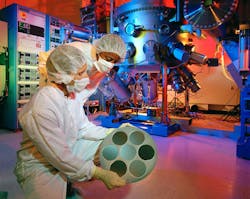DARPA chooses Teledyne to design advanced RF and microwave MMICs for communications and sensing at G-band
ARLINGTON, Va. – U.S. military researchers needed a company to develop fabrication and integration technologies to create compact, high-performance RF and microwave electronics to enable communications and sensing systems at G-band frequencies. They found their solution from Teledyne Technologies Inc.
Officials of the U.S. Defense Advanced Research Projects Agency (DARPA) in Arlington, Va., announced an $18.6 million contract last week to the Teledyne Scientific & Imaging segment in Thousand Oaks, Calif., for the Electronics For G-Band Arrays (ELGAR) project.
Experts from the DARPA Microsystems Technology Office want Teledyne experts to develop monolithic microwave integrated circuits (MMICs) and receive array front-end test articles able to operate in the sub-terahertz G-band frequency range between 110 and 300 GHz for applications like radio astronomy, remote security sensing, and telecommunications.
The growing thirst for information in military and commercial applications is driving RF and microwave technologies towards increasingly higher data rates and wider bandwidths of operation, DARPA researchers say. This drives systems designs in higher operating frequencies to support large channel bandwidths.
Today’s 5G cellular networks, for example, operate at 6 GHz and below, and researchers are considering future 5G communications at millimeter wave frequencies from 24.25 GHz to 52.60 GHz. 6G will push frequencies even higher for large-channel bandwidths and high-channel capacities.
The upper millimeter-wave G band of 110 to 300 GHz represents an attractive, underused portion of the electromagnetic spectrum for high-rate data communications -- particularly above 200 GHz, where atmospheric absorption is low.
Today, however, RF electronics adequate to support operation in this frequency band does not yet exist -- particularly for size, weight, and power (SWaP)-constrained applications. The efficiency of G-band electronics today is poor, and must be addressed to make G-band systems viable.
RF and microwave experts can build G-band communications arrays with silicon-based RF integrated circuits or with III-V compound semiconductor MMICs. Each approach has advantages and limitations.
Through significant investment in programs such as Sub-millimeter Wave Imaging Focal-plane Technology (SWIFT), Terahertz (THz) Electronics, and Nitride Electronic NeXt-Generation Technology (NEXT), DARPA has developed III-V transistor technologies in indium phosphide and gallium nitride that can overcome the gain and breakdown voltage limitations of silicon- based transistors at G-band.
DARPA is interested in heterogeneous integration approaches that result in transmit and receive circuit compactness that enable a revolutionary increase in power density and power efficiency of MMICs and phased arrays at G-band.
Related: RF and microwave designers grapple with crowded spectrum
The ELGAR program seeks to develop integration technologies to implement demonstration and validation circuits and test articles including compact, high-efficiency G-band power amplifier MMICs and transmit and receive array front-end test articles that operate at 220 GHz.
DARPA anticipates that the most challenging performance aspects of these MMICs and array test articles will be achieving 30 percent power amplifier power-added efficiencies, and more than 34 Watts per square centimeter transmit array power density and 24 percent transmit array efficiency at the 220 GHz operating frequency.
For more information contact Teledyne Scientific & Imaging online at www.teledyne-si.com, or DARPA at www.darpa.mil.
About the Author
John Keller
Editor-in-Chief
John Keller is the Editor-in-Chief, Military & Aerospace Electronics Magazine--provides extensive coverage and analysis of enabling electronics and optoelectronic technologies in military, space and commercial aviation applications. John has been a member of the Military & Aerospace Electronics staff since 1989 and chief editor since 1995.
